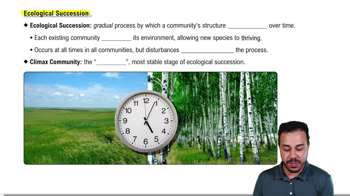Table of contents
- 1. Introduction to Biology2h 42m
- 2. Chemistry3h 40m
- 3. Water1h 26m
- 4. Biomolecules2h 23m
- 5. Cell Components2h 26m
- 6. The Membrane2h 31m
- 7. Energy and Metabolism2h 0m
- 8. Respiration2h 40m
- 9. Photosynthesis2h 49m
- 10. Cell Signaling59m
- 11. Cell Division2h 47m
- 12. Meiosis2h 0m
- 13. Mendelian Genetics4h 44m
- Introduction to Mendel's Experiments7m
- Genotype vs. Phenotype17m
- Punnett Squares13m
- Mendel's Experiments26m
- Mendel's Laws18m
- Monohybrid Crosses19m
- Test Crosses14m
- Dihybrid Crosses20m
- Punnett Square Probability26m
- Incomplete Dominance vs. Codominance20m
- Epistasis7m
- Non-Mendelian Genetics12m
- Pedigrees6m
- Autosomal Inheritance21m
- Sex-Linked Inheritance43m
- X-Inactivation9m
- 14. DNA Synthesis2h 27m
- 15. Gene Expression3h 20m
- 16. Regulation of Expression3h 31m
- Introduction to Regulation of Gene Expression13m
- Prokaryotic Gene Regulation via Operons27m
- The Lac Operon21m
- Glucose's Impact on Lac Operon25m
- The Trp Operon20m
- Review of the Lac Operon & Trp Operon11m
- Introduction to Eukaryotic Gene Regulation9m
- Eukaryotic Chromatin Modifications16m
- Eukaryotic Transcriptional Control22m
- Eukaryotic Post-Transcriptional Regulation28m
- Eukaryotic Post-Translational Regulation13m
- 17. Viruses37m
- 18. Biotechnology2h 58m
- 19. Genomics17m
- 20. Development1h 5m
- 21. Evolution3h 1m
- 22. Evolution of Populations3h 53m
- 23. Speciation1h 37m
- 24. History of Life on Earth2h 6m
- 25. Phylogeny2h 31m
- 26. Prokaryotes4h 59m
- 27. Protists1h 12m
- 28. Plants1h 22m
- 29. Fungi36m
- 30. Overview of Animals34m
- 31. Invertebrates1h 2m
- 32. Vertebrates50m
- 33. Plant Anatomy1h 3m
- 34. Vascular Plant Transport1h 2m
- 35. Soil37m
- 36. Plant Reproduction47m
- 37. Plant Sensation and Response1h 9m
- 38. Animal Form and Function1h 19m
- 39. Digestive System1h 10m
- 40. Circulatory System1h 49m
- 41. Immune System1h 12m
- 42. Osmoregulation and Excretion50m
- 43. Endocrine System1h 4m
- 44. Animal Reproduction1h 2m
- 45. Nervous System1h 55m
- 46. Sensory Systems46m
- 47. Muscle Systems23m
- 48. Ecology3h 11m
- Introduction to Ecology20m
- Biogeography14m
- Earth's Climate Patterns50m
- Introduction to Terrestrial Biomes10m
- Terrestrial Biomes: Near Equator13m
- Terrestrial Biomes: Temperate Regions10m
- Terrestrial Biomes: Northern Regions15m
- Introduction to Aquatic Biomes27m
- Freshwater Aquatic Biomes14m
- Marine Aquatic Biomes13m
- 49. Animal Behavior28m
- 50. Population Ecology3h 41m
- Introduction to Population Ecology28m
- Population Sampling Methods23m
- Life History12m
- Population Demography17m
- Factors Limiting Population Growth14m
- Introduction to Population Growth Models22m
- Linear Population Growth6m
- Exponential Population Growth29m
- Logistic Population Growth32m
- r/K Selection10m
- The Human Population22m
- 51. Community Ecology2h 46m
- Introduction to Community Ecology2m
- Introduction to Community Interactions9m
- Community Interactions: Competition (-/-)38m
- Community Interactions: Exploitation (+/-)23m
- Community Interactions: Mutualism (+/+) & Commensalism (+/0)9m
- Community Structure35m
- Community Dynamics26m
- Geographic Impact on Communities21m
- 52. Ecosystems2h 36m
- 53. Conservation Biology24m
51. Community Ecology
Community Structure
Problem 4
Textbook Question
Pioneer species tend to have high ________ and lower survivorship.
 Verified step by step guidance
Verified step by step guidance1
Understand the concept of pioneer species: Pioneer species are the first organisms to colonize a barren or disturbed ecosystem. They play a crucial role in ecological succession by preparing the environment for subsequent species.
Identify the characteristics of pioneer species: These species often have traits such as rapid growth, high reproductive rates, and the ability to thrive in harsh conditions. They are typically opportunistic and can quickly establish themselves in new areas.
Explore the concept of high reproductive rates: Pioneer species tend to produce a large number of offspring to increase the chances of survival in unpredictable environments. This is often referred to as having high fecundity.
Examine the concept of lower survivorship: Despite their high reproductive rates, individual pioneer species may have lower survivorship due to the challenging conditions they face. This means that while many offspring are produced, fewer survive to adulthood.
Connect these concepts to ecological succession: Pioneer species initiate the process of ecological succession, gradually altering the environment to make it more suitable for other species, which often have higher survivorship and lower reproductive rates.
 Verified video answer for a similar problem:
Verified video answer for a similar problem:This video solution was recommended by our tutors as helpful for the problem above
Video duration:
2mPlay a video:
Was this helpful?
Key Concepts
Here are the essential concepts you must grasp in order to answer the question correctly.
Pioneer Species
Pioneer species are the first organisms to colonize barren or disturbed environments, initiating ecological succession. They are typically hardy and adaptable, capable of surviving in harsh conditions with minimal resources. Their presence helps modify the environment, making it more suitable for subsequent species.
Recommended video:

Biological Species Concept
Ecological Succession
Ecological succession is the process by which the structure of a biological community evolves over time. It begins with pioneer species and progresses through various stages until a stable climax community is established. This process involves changes in species composition, diversity, and ecosystem structure.
Recommended video:
Guided course

Ecological Succession
Survivorship
Survivorship refers to the proportion of individuals in a population that survive to a particular age. In the context of pioneer species, they often exhibit lower survivorship due to their strategy of producing many offspring with the expectation that only a few will survive in the harsh initial conditions of a new environment.
Recommended video:
Guided course

Survivorship
Related Videos
Related Practice
Multiple Choice
What is a zoonotic pathogen?
1005
views


